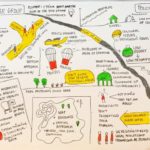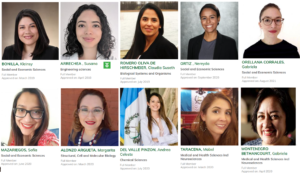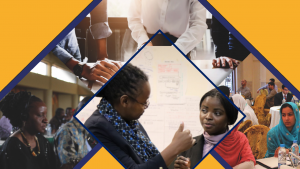
Shifts in the sector: The evolution of our evidence-informed policy work – Part 2
In the second of a two- part series, Emily Hayter, Senior Programme Specialist for INASP’s Evidence Informed Policy and Practice, shares the key learning and emerging directions of our work to support capacities for evidence use within the global South.
The evidence-informed policy (EIP) sector has been an exciting space to work in in the last few years. As our approach has evolved, there have been three main shifts in our work: the EIP and governance sectors have started to move more closely together; meanwhile the EIP space has been growing, especially in Africa; and we at INASP have kept our broad view of evidence systems, but have deepened our understanding of specific components of this.
Lesson 1: The governance sector has much to teach us
For a long time, evidence-informed policy work was disconnected from the governance sector, despite our common interests in how public institutions change. Since BCURE, there has been much more recognition across the evidence-informed policy community (including in the BCURE evaluation, and the new SEDI programme, which responds directly to it) that EIP community’s growing interest in politics and governance bring us closer to those working in governance, politics and public administration, whether it’s about how to ‘think and work politically’ how to understand the nitty gritty of institutional reform.
Unlike BCURE, both current evidence projects we’re involved in, SEDI and DAP, did political economy analyses, and explicitly aim to ‘think and work politically’. At INASP we have always seen evidence as one thread in a complex, political picture, and throughout BCURE we and our partners reflected constantly on the different political contexts we were engaging in. But in the last couple of years the INASP programme team has started to experiment with how to more explicitly integrate contextual analysis into our project design and decision making—we’ll be sharing our reflections on this very soon!
We’re also focusing much more on understanding government organisational structures, processes and cultures that affect evidence use. Whereas in our earlier work, our main entry point was individuals, building on BCURE, we now focus much more on understanding the organisational structures, systems, plans and cultures that affect evidence use. Our pilots of the Context Matters Framework with Politics & Ideas, in collaboration with the Environmental Protection Agency in Ghana and the Secretariat of Public Administration in Peru, were critical steps in improving our understanding not only of what these factors look like, but of the kinds of partnerships with government agencies which result in the most genuine and productive entry points. Other inspirations for this area of work have been the partnership between the Department of Environmental Affairs in South Africa and ODI, and the problem-driven iterative adaptation approach to building state capability.
Skills are still part of the picture, and now we’re aiming to build a better understanding of capacity development models in public sector contexts. Our experience gives us a good understanding of adult learning methodologies. But we are continuing to learn about what this looks like within civil service training institutes and how it relates to competency models, performance and management systems. Our VakaYiko partnership with the Ghana Civil Service Training Centre, with Kirchuffs Atengble (then of GINKs, now of PACKS Africa) laid the groundwork for this. Last summer, our first Blavatnik School summer student, Adetola Adegbite, built on this in his summer project, which helped us understand the existing literature and thinking around competency models in civil service contexts, and how our work can link to this.
Lesson 2: The sector is growing—especially in Africa
Growing the thinking as well as the practice. The Africa Evidence Network has grown since its beginnings in BCURE, leading the discussion about evidence-informed policy in the African region and acting as a meeting point for those inside and outside government championing innovative approaches to evidence use. The AEN is always a space for us to explore new thinking, whether challenging us to get out of our ivory towers and connect our evidence work more with activism, to leading discussions on decolonising capacity development and reminding northern actors of the important lessons to be learned from the global south whether the South African evidence system or Uganda’s rapid response services.
Globally, we’ve also seen evidence discussions expanding, from the new online course offered by the Blavatnik School at the University of Oxford, to the EU’s work on producing a skills map for evidence use in policy and the growing International Network for Government Science Advice, with regional chapters in Asia, Africa, Latin America and the Caribbean, and North America. Many of these networks also use evidence skills as a first entry point, and some are starting to expand from there to address broader organisational and systemic factors too.
Research work by Langer at al on the ‘Science of Using Science’ (2016), Parkhurst’s ‘Good Governance of Evidence’ (2016), and, most recently, Goldman and Pabari’s case studies from Africa (2020) have all shaped thinking in the sector, underscoring the need to understand organisational systems, structures and behaviours within government agencies, adding nuance and depth to our understanding of the way these manifest in real governments, and offering ways to conceptualise the kinds of changes we hope to see through our work. CLEAR-AA’s forthcoming book on evidence use in African parliaments will offer a wealth of insights from parliaments across the continent about how they engage with evidence, and will also help to situate this debate within contemporary governance thinking.
Lesson 3. A broad view of the system is useful, but there is room to better understand its component parts
As an organisation which has partnerships across research and evidence systems, from researchers to publishers, universities, and government agencies, INASP has always taken a broad view of evidence systems. We believe that effective evidence use combines at least four intersecting types of evidence: practice-informed evidence, including evaluations; data and statistics; research; and citizen knowledge. Our existing work gave us a good grounding in research actors and systems, but in the last few years we’ve been getting to know other types of actors, and also starting to apply our ‘evidence lens’ to a broader range of sectors. Importantly, we are also shifting to a more systemic view, not only of ‘supply’ or ‘demand’ as separate, but exploring the interface between them.
- Growing our parliamentary strand of work. At INASP our work with parliaments dates back about 10 years, but our partnership with the African Centre for Parliamentary Affairs (ACEPA) since 2016 has vastly improved our understanding of parliaments. Together we have developed out a more nuanced understanding of the unique issues to consider when applying an evidence-informed policy lens to parliaments and collaborated on a peer learning initiative with five African parliaments.
- New types of actors Our partnership with ACEPA on the DAP project is also our first with a statistics agency—a great opportunity to learn more about the role they play in evidence systems. And our collaboration with the UNICEF Office of Research—Innocenti to conduct evidence diagnostics in South Asia and East Asia Pacific regional offices has been a fascinating opportunity for us to learn about UN agencies as evidence actors.
- New sectors, new regions. We’ve started to apply our broad evidence lens more to specific sectors, such as health through partnership with the EHPSA programme and environment with the Environmental Protection Agency in Ghana. The SEDI programme sees us working with leading think tanks specialised in economics and public financial management (SDPI in Pakistan, ACET in Ghana and EPRC in Uganda).and we’re currently collaborating with our second Blavatnik School summer placement colleague, Davi Romao of the Veredas Institute, to understand factors affecting evidence use in social policy in Brazil.
- Working to better integrate gender. Gender equity has been an underexplored area in much of the EIP sector, as the BCURE evaluation pointed out. Following our organisational gender audit and in line with our new INASP strategy which has a strong focus on equity, we have been working with our Gender and Diversity Hub to review our Context Matters Framework with a gender lens so that we can better incorporate this in future (reflections will be shared in a forthcoming blog post).
Our evidence work has grown in both breadth and depth in the last five years. Our interest in organisational change in the public sector has pushed us outside a traditionally researcher-driven space to learn more from those working on governance and institutional reform, as well as from policymakers themselves. But we’re also adding nuance and depth to our understanding of evidence systems, both at different levels of government and within different sectors and evidence types. We appreciate all our partnerships and collaborations with leading evidence champions around the world that have enabled us to continue to grow our evidence work at INASP, and we look forward to continue to work together on this fascinating issue which has such important implications for our governments and our societies.
Please do get in touch to discuss these ideas – and opportunities to collaborate. Ehayter@inasp.info
Photo by Joshua Torres on Unsplash

 Previous Post
Previous Post Next Post
Next Post


